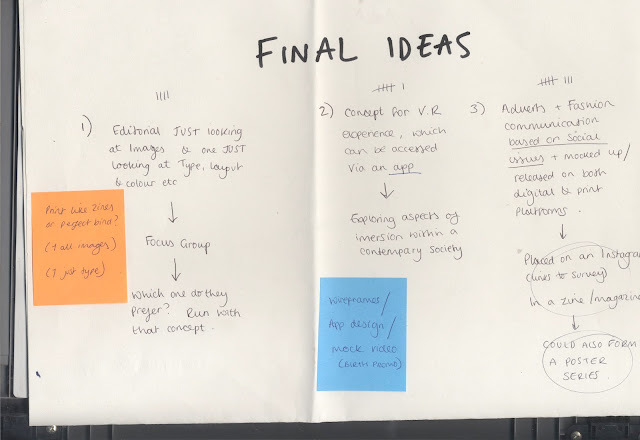COP 3 Evaluation
Evaluating the success of this project will be been particularly hard, due to my split priorities between here and my placement. I have found this module extremely challenging- looking back, I would have chosen a different research topic which has a formal ‘yes/no’ outcome, rather than mine which I feel is shadowed with subjectivity. I have learnt lots about fashion communication - the research process has definitely taught me the importance of both epistemology and practical development side by side, with studio based work informing the research project. The final advertising design for the practical component is a transferable design, utilising a mixture of Caslon, a proud British Typeface and Gothica Moderne, a modern take on Fraktur, reinventing the connotations of the font to reflect contemporary design with nods to history. The structure gives a definable aesthetic to #GetWoke, yet may generate confusion due to the minimalist design, and the use of TheWokening and GetWoke as visual signifiers gives a transferable but connected identity. However, the viewer may question, what is it? Which is when they will go to the website or Instagram, which will feature immersive scroll overs and interactive design. If I had more time, I would illustrate these concepts however that is slightly outside my area of expertise. The image can be altered and fit this format, with the centre typographic layout adjustable where appropriate.
It is also good to note that when getting summative feedback, they understood what each image was about, without the aid of typography, just through art direction and props. Feedback also suggested that I print off the images without the #getwoke hashtag, showcasing the communication on it’s own and testing the audience on what they think each image means, rather than just my feedback group, which could be much broader.
The Survey highlights howe the target audience (millennials) generally consumes any fashion communication, with 75% saying online via social platforms. Looking back, I wish I had illustrated a wider amount of possibilities to utilise this platform, and explaining how the design was informed by popular culture in a better way. The essay could have also been improved, I could have mentioned a wider range of sources (i.D, Dazed & Confused, Kilnfolk, Hunger etc) and not just relate everything back to Vogue. I also could have discussed the DIY publishing movement more as a way to design for protest, using fashion as that signifier. I feel the project progressed enormously throughout the development of research and ideas - furthermore, I have realised that I find it challenging to talk about the graphic communication in high fashion images without relating it back to the clothes, so I wish I had chosen magazines I wasn’t so connected to, for reasons other than graphic design. I also could have explored more theories within the essay, delving deeper into semiotics and the ethics of fashion communication and fashion advertising.
Synthesis
Implications they could have on Society’, the research study investigates how fashion advertisements
and editorials can be a perfect tool for providing a social and historical commentary. Research says
how identities are broken down by what we consume - Baudrillard & Klein, so by using these methods
of consumtion as visual signifiers, we are able to track popular trends and thus allign them with a social
movement, which often corelates to a year. We live in a sophistocated visually litterate society (Sontag).
so by utilising these principles we can transcend elements of immersion and fantasy generally conveyed
through an aspirational editorial and relate them to real world issues. I explore how high fashion editorials
have the potential to act as tools of escapism, with fashion images often well coded with semiotics to
form a piece of communication all on it’s own. Art direction, props, location, styling, syntax etc., all
contribute to the success of that visual communication. However, by living in a image based society, the
spectacle of the image also holds negative connotations, such as The Male Gaze and implications on
physical health - In response to this, I created poster series advertising a conceptual platform which
showcases possitivly coded imagery. TheWokening is a space for creatives to show their photographic,
illustrative and graphic work relating to social issues of the day, exploring aspects of reality or fantasy.
In primary research, I discovered that people engaged with creative content most online, mainly through
social platforms like Instagram- so it was essential to include accessibility for the audience to maximise
success. After conducting primary and secondary research into current social issues, with the aid of
feedback. I chose to visually represent 4 issues: Trump’s Presidency, Pro-Diversity, The Tampon Tax/
Fairness between genders and society being suffocated by brands.
The deliverables are formed into a poster series, advertising a quarterly print magazine, which show-
cases creatives work which tackles contemporary social and political issues, in a lighter way than
newspapers, targeted at a millenial target audience. Primary research shows that this demographic
does keep up to date on social issues, but only as a byproduct of being online - so more a instagram
and concept website will facilitate this, aided by social media advertising. The design is ambiguous to
encourage independent research into the movement, as it is designed with openness and translucency
in mind. It will be accompanied by a concept website, showcasing the editorial content online, as well
as an Instagram page to allow easier interaction with the target audience.




















































